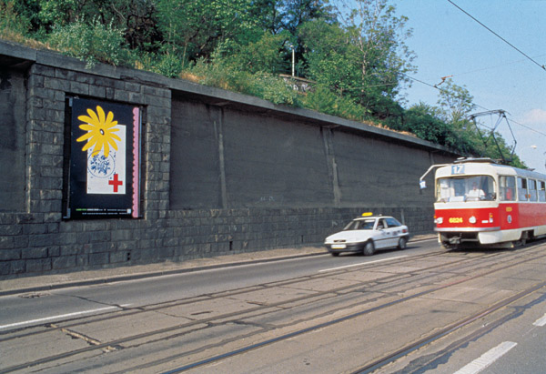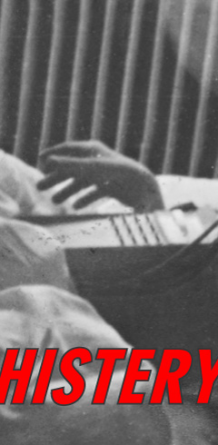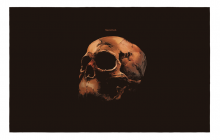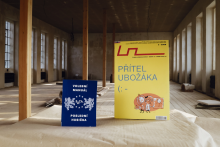| Zeitschrift Umělec 2000/3 >> Public space as a Private Thing | Übersicht aller Ausgaben | ||||||||||||
|
|||||||||||||
Public space as a Private ThingZeitschrift Umělec 2000/301.03.2000 Jana Tichá | info | en cs |
|||||||||||||
|
The Center for Contemporary Art initiated an art project in public space three years ago in Prague. In the fall of 1997, an exhibition showed fifty proposals in Veletržní Palac, from which two-thirds of them have been gradually realized. I think that is a successful score, especially if we consider that everyone realized their projects in public spaces, whether they were public squares, supermarkets or in trams. The actual creation of these works, as a rule, occupies only a fraction of the total time necessary to finally show it, due to all of the required official papers. Of course even here the exception proves the rule: a few clicks on the Internet are enough to install work. The Internet is still maybe the freest, smoothest examined public space. In 1997, it was more or less a hot new thing in the Czech Republic, so only three projects were done on the Internet. One created a program for television broadcast, while most of the artists chose tangible spaces of a wide scale for their work, which included everything from the pages of a magazine, advertising spaces and shop windows, city squares, to spaces out in the open countryside.
The diversity of environments reflects the diversity of the possible interpretations of the notion of public space: the organizer’s original intent was for the public space to be for the purpose of the project’s comprehension, wherever the public entered, with the exception of museums and galleries. The work placed outside of typical art spaces acts as “an advertisement for art” and as a kind of planting of awareness in the people who under their own initiative would never go to see contemporary art. Research done by students and teachers at the Department of Cultural Sciences UK in Prague came up with an interesting conclusion. The questionnaire was aimed at the reception of artwork created within the framework of Art in Public Spaces, through the examination of 28 works of art realized in the fall of 1998. The 11 students who took part in the investigated terrain spoke to 394 respondents. More than three-quarters of the people in the investigation who came in contact with a work didn’t know about the event. While half of the respondents didn’t identify the work as art, nearly two-thirds were unable to understand it. Two-thirds of the respondents more or less agreed that similar events would be welcome in the city, especially to liven up city spaces, while others said it was a good opportunity to expand the public’s interest in contemporary art. The most striking thing was the difference between the answers to questions concerning the meaning of contemporary art in general and its place in public space (e.g. 73% affirmative answers to the question, “Do you think there should be more public presentations of contemporary art?”) and the respondents idea of what contemporary art actually is and their ability to identify it. The attempt “Not to look uncultured” could have played a role in this. However, it shows the public is open to experiencing meeting contemporary art (expressly negative reaction hovered around10%). It’s interesting that comprehensibility isn’t a required condition for the identification of a work of art. The public tends to identify works of art that are distinctly different from their everyday environment. And vice-versa, work that uses a subversive strategy, and implements subtle shifts and mimicry are seldom recognized as art, even though they could be easily understood. It would be interesting to know how the “involuntary” public felt about this year’s contribution. Several reactions so far perhaps make good anecdotes. Just outside Parliament, the artwork Perception Machine by Tomáš Kotík and Julie Schulzová aroused fierce reaction from member of ČSSD Stanislav Křeček who sent an open letter to the mayor of Prague demanding that the work be removed. He said to ČTK, “ I consider the placement of this kind of thing, this product, artwork, or whatever it really is, in this environment a significant intrusion in Malá Strana, and it somehow ended up here without any discussion and without the opinions of the population.” The mayor responded that the object placed on Sněmovní street had the proper papers, and the artists didn’t comment on its value. Other members said they were offended by the small plaque with the inscription “Třinec Steel, Moravia Steel.” Both companies had sponsored the project. So the project drilled home its unwanted political barb, dreaming away like pure esthetic “perceptual aid,” drawing attention to the complex character of the city environment, where the horizontal and vertical architecture “redefines” the hilly and uneven terrain. Barbara Benish’s work Flower Power, at the embankment of Captain Jaroše, is not consciously based on politics. The wall at the foot of Letna Park is of unusual scale, considering the number of people passing by in cars rather than walking. Moreover it is a place weighted down with history. The wall itself was built in the 1950s to accompany the Stalin monument, which was only a short distance up the hill on Letna. The wall was a gallery for Communist propaganda at that time, where they would place the standard hammer and sickle symbols of the regime. Throughout the 1990s, the wall remained empty, as, oddly enough, nobody thew up any billboards—as if the hill were cursed. Barbara Benish broke the spell last year with her pictures of stylized flowers, inspired by children’s drawings, pop art, and hippy esthetics. She made good use of her experience with Los Angeles “murals,” which entirely cover and are spread all over the concrete walls in the city and are something between wall paintings and high quality graffiti. Often times the only difference between them is if the painter is an anonymous Hispanic or a Frank Stella. Barbara’s pictures are to be at the foot of Letna until fall, after which students from AVU will use the space as rotating art niches. This is the formation of a very public space in an attractive place in the center of Prague. The public is usually understood as something in contrast to and separate from the private—two impervious spheres that are deeply imbedded in our psyche. In relation to this, I consider it important to mention that the first open exhibition gallery at the foot of Letna was successful thanks to sponsors’ contributions, which four Praguers, as private people, were granted. Art in a Public Space: realized in 2000: Art Within Range (Petr Hludeček, celebration on Střelecký Island, May 5), Perception Machine II (Tomáš Kotík, Julie Schulzová, Sněmovní Street, Prague 1, Opening May 5), Flower Power (Barbara Benish, the wall at Letná Orchard, on Nábřeží kpt. Jaroše, opening June 6), Danae (Michal Sedlák, the big pond in Stomovká, opening June 28), Night Watch (Milan Cais, the roof of the Goethe Institute, Masarykovo nábř., Praha 1, Fall 2000) and Fish (Michal Gabriel, Prague metro, fall 2000).
01.03.2000
Empfohlene Artikel
|
|||||||||||||
|
04.02.2020 10:17
Letošní 50. ročník Art Basel přilákal celkem 93 000 návštěvníků a sběratelů z 80 zemí světa. 290 prémiových galerií představilo umělecká díla od počátku 20. století až po současnost. Hlavní sektor přehlídky, tradičně v prvním patře výstavního prostoru, představil 232 předních galerií z celého světa nabízející umění nejvyšší kvality. Veletrh ukázal vzestupný trend prodeje prostřednictvím galerií jak soukromým sbírkám, tak i institucím. Kromě hlavního veletrhu stály za návštěvu i ty přidružené: Volta, Liste a Photo Basel, k tomu doprovodné programy a výstavy v místních institucích, které kvalitou daleko přesahují hranice města tj. Kunsthalle Basel, Kunstmuseum, Tinguely muzeum nebo Fondation Beyeler.
|

































 We Are Rising National Gallery For You! Go to Kyjov by Krásná Lípa no.37.
We Are Rising National Gallery For You! Go to Kyjov by Krásná Lípa no.37.
Kommentar
Der Artikel ist bisher nicht kommentiert wordenNeuen Kommentar einfügen